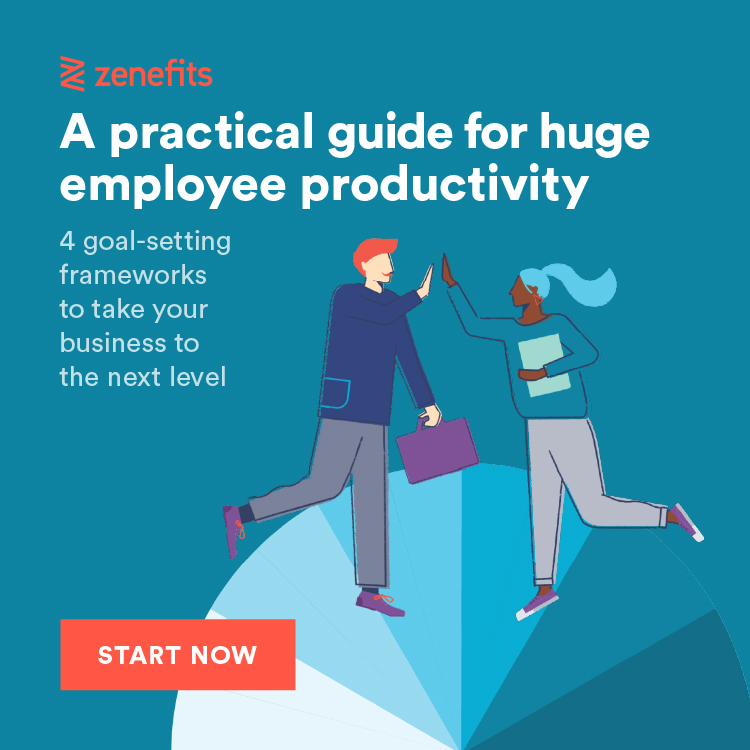
Creating goals is critical to the success and growth of your company. Without goals to work toward, your employees can lack connection, commitment, and purpose. Goal setting provides a myriad of benefits for your employees — motivation, engagement, and a measurement of success are just a few.
It’s one thing to want to set goals, but actually creating effective ones can be easier said than done. However, putting in the time and effort to do so is a worthy investment for your employees and your organizational health.
Let’s look at why goal setting is important, plus tips on how to create an effective team or company goal.
- Importance of goal setting
- Goal-setting frameworks to consider
- V2MOMs
- OKRs
- “The What’s and The How’s”
- What constitutes a well-written company or team goal?
Importance of goal setting
There’s no doubt that setting goals is beneficial to yourself, your teams, and your company. Every organization has a larger vision, and ensuring employees are aligned with it and set up for success is key.
Here are some of the benefits that goal setting provides:
Motivation and clarity. If employees don’t know what the purpose of their role is or what their work is meant to achieve, it can lead to low morale and productivity. Goals help provide motivation, confidence, and job satisfaction.
Engagement. Employees want to feel connected to their company’s ambitions and progress. If they don’t understand their contribution to company success, they’re more prone to becoming disengaged — which can lead to poor performance and other negative consequences. When goals are set effectively, they “can help improve employee engagement in a way which elevates performance and benefits organizations overall,” according to McKinsey research.
Work prioritization. Setting clear goals helps employees know what work to prioritize and complete on time. Managing goals can lead to stronger planning, organization, and focus skills.
Measure of success. Employees want to know if they’re performing well and if the company is, too. Goals help evaluate employee and company performance, and encourage individuals to measure their work and aim for more than the bare minimum.
Goal-setting frameworks to consider
To align each person’s work to your company’s larger vision, use cascading goals. Cascading goals are a hierarchical framework — strategic goals are set at the highest or executive level, and then cascade down throughout the rest of the organization.
There are many models of cascading goals that could work for your business, and no one-size-fits-all approach. We’ll go over a few versions of cascading goals that you could consider.
V2MOMs
V2MOMs, or Vision, Values, Methods, Obstacles and Measurement, is a cascading goal model developed by Marc Benioff, Chair, Chief Executive Officer and Founder of Salesforce.
This acronym works to frame these business areas:
Vision: Defines what you want to do or achieve.
Values: Your company’s principles and beliefs that help you pursue your vision.
Methods: The action items and tactical steps needed to take to get the job done.
Obstacles: Anticipated challenges you’ll need to overcome to achieve the vision.
Measures: The ways in which you measure achievement.
The model can be used once by your leadership team and disseminated across the business. Or you could require each department, or even each individual, to draft their own V2MOMs that snap to the overarching goals.
OKRs
OKRs, or Objectives and Key Results are used at companies like Google, Linkedin, Twitter, and Zynga.
To use OKRs, you develop 2-3 “objectives” and 2-3 “key results” that align to those objectives in a given window of time, classically 1-3 months. Upper management identifies the objectives, while individual teams spell out individual key results. Each key result is accompanied by a confidence interval, to keep employees motivated. The lower the confidence level, the harder it is to achieve the goal.
“The What’s and The How’s”
“The What’s and The How’s” is an approach whose name pretty much describes how it works. The model aims to clarify what you need to get done, and how you’re going to do it.
In a What’s and How’s model, leadership identifies top-level business goals. Then each team and person layers on their associated goals. These are the “what’s.” Each “what” should come with an attached metric to assess goal achievement. After the “what’s” are decided, each group then adds “how” they expect to complete the stated goal. The “how’s” are geared to reflect some of the softer-skill values of the company that help describe how the business is oriented to drive its goals. This could be process design, operations, behavior, or values among other things. It might also be the reduction of things, like meetings, or redundancies.
Whats:
What are you trying to accomplish?
What are the metrics that validate goal attainment?
Hows:
How is your business designed to achieve goals?
How do you expect your employees to handle themselves behaviorally to be in alignment with the goals?
What constitutes a well-written company or team goal?
One of the biggest goal attainment killers is bad goal setting. Good goals are SMART. They are:
- Specific
- Measurable
- Achievable
- Relevant
- Time-Bound
Good goals specify what’s intended to get done, by when. They demonstrate the relevance or alignment to larger initiatives, and put a time cap on when it’s expected to be completed.
Here are some additional points to remember about effective goal setting:
Connect individual goals to larger company goals. When each of your employees’ individual efforts directly helps your business achieve its overarching goals, that is when your business starts humming. Make sure your employees understand your broader company strategy, and how their efforts affect it.
Show your partnership in achieving goals. Make sure to check in regularly with your employees about goal attainment, and monitor progress. Being proactive about providing feedback demonstrates support and investment into your employee’s work. Also with proactive partnership, you’ll be able to catch any issues with goal attainment before it’s too late.
Make goals SMART and adaptable. In addition to creating goals that are SMART (Specific, Measurable, Achievable, Relevant, and Time-Bound), also make them adaptable. Environments fluctuate over time, and goals should evolve with them. Don’t wait until review season to go over goals; adapt them when business areas change. If your employee hits any roadblocks along the way, make sure they’re comfortable discussing them with you. A goal that’s too challenging to attain may mean it needs reworking.







